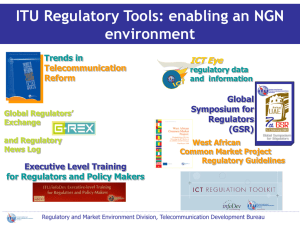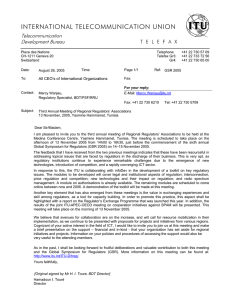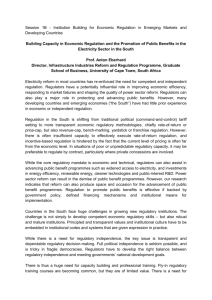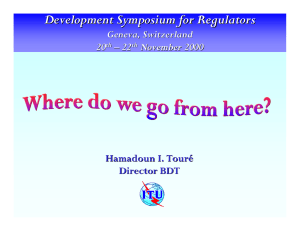Trends in Telecommunication Reform 2002: Effective Regulation Executive Summary
advertisement
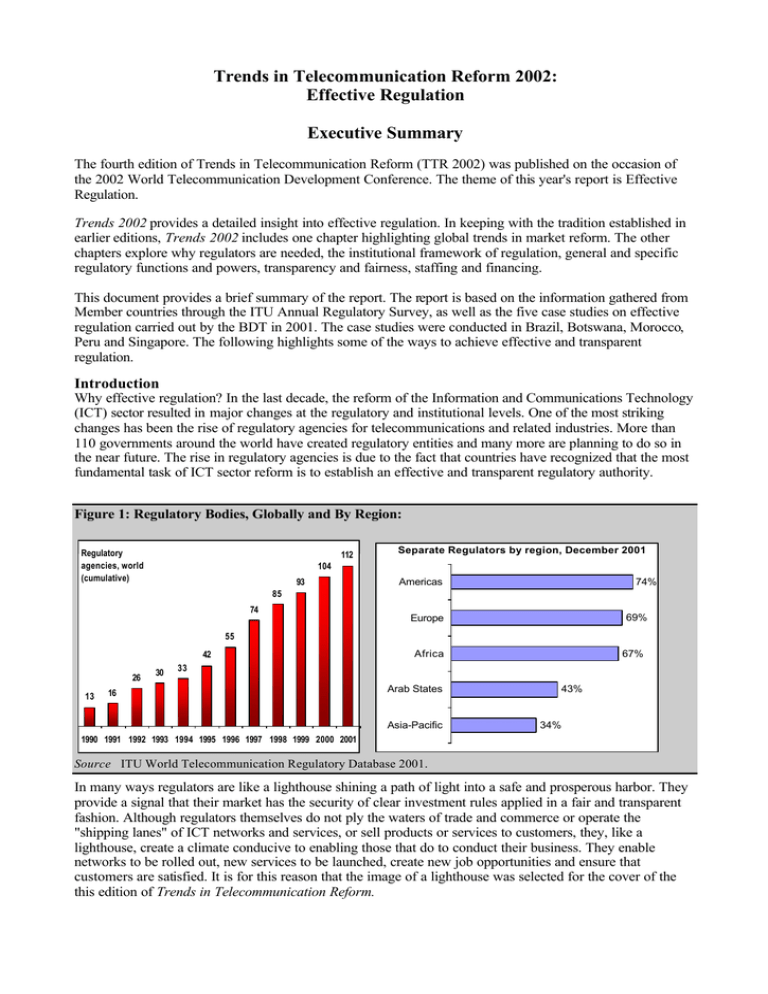
Trends in Telecommunication Reform 2002: Effective Regulation Executive Summary The fourth edition of Trends in Telecommunication Reform (TTR 2002) was published on the occasion of the 2002 World Telecommunication Development Conference. The theme of this year's report is Effective Regulation. Trends 2002 provides a detailed insight into effective regulation. In keeping with the tradition established in earlier editions, Trends 2002 includes one chapter highlighting global trends in market reform. The other chapters explore why regulators are needed, the institutional framework of regulation, general and specific regulatory functions and powers, transparency and fairness, staffing and financing. This document provides a brief summary of the report. The report is based on the information gathered from Member countries through the ITU Annual Regulatory Survey, as well as the five case studies on effective regulation carried out by the BDT in 2001. The case studies were conducted in Brazil, Botswana, Morocco, Peru and Singapore. The following highlights some of the ways to achieve effective and transparent regulation. Introduction Why effective regulation? In the last decade, the reform of the Information and Communications Technology (ICT) sector resulted in major changes at the regulatory and institutional levels. One of the most striking changes has been the rise of regulatory agencies for telecommunications and related industries. More than 110 governments around the world have created regulatory entities and many more are planning to do so in the near future. The rise in regulatory agencies is due to the fact that countries have recognized that the most fundamental task of ICT sector reform is to establish an effective and transparent regulatory authority. Figure 1: Regulatory Bodies, Globally and By Region: Regulatory agencies, world (cumulative) 112 Separate Regulators by region, December 2001 104 93 Americas 74% 85 74 69% Europe 55 42 26 13 30 Africa 67% 33 16 Arab States Asia-Pacific 43% 34% 1990 1991 1992 1993 1994 1995 1996 1997 1998 1999 2000 2001 Source ITU World Telecommunication Regulatory Database 2001. In many ways regulators are like a lighthouse shining a path of light into a safe and prosperous harbor. They provide a signal that their market has the security of clear investment rules applied in a fair and transparent fashion. Although regulators themselves do not ply the waters of trade and commerce or operate the "shipping lanes" of ICT networks and services, or sell products or services to customers, they, like a lighthouse, create a climate conducive to enabling those that do to conduct their business. They enable networks to be rolled out, new services to be launched, create new job opportunities and ensure that customers are satisfied. It is for this reason that the image of a lighthouse was selected for the cover of the this edition of Trends in Telecommunication Reform. Sector Reform Sector reform has become the norm for ITU Member States, a majority of which have at least init iated a sector reform programme, if not fully embarked on the path of sector reform. The momentum of the global sector reform movement that crystallized during the 1990s carried over into the new century, even as the economic boom of the 1990s in many countries plateaued and faltered. While the cooler economic outlook of 2001 clearly had an effect on sector restructuring - particularly on planned privatizations and spectrum auctions - governments continued their commitment to opening markets to competition in order to better meet their universal service goals. Increasingly, governments are realizing that the value of their national ICT assets is linked to the strength of their sector reform programmes. Likewise, the growth in the number of ICT service subscribers worldwide continues to swell, especially for mobile cellular and Internet access offerings. These services are, by and large, now provided in a competitive framework that requires effective regulators to ensure fair and transparent market rules. Put simply, investors in both incumbent and competitive operators require the security of a strong sector reform package. More than ever, countries realize that their efforts to promote ICT sector growth are inexorably linked to sector reform. Figure 2: The Market Just Keeps Growing Growth of competition in selected services (left) and growth in the number of subscribers (right) Local International Countries Long distance Cellular mobile 140 Main telephone lines Internet users (million) 1600 120 1400 100 1200 Mobile subscribers 1000 80 800 60 600 40 400 20 200 0 0 1995 1997 2000 2001 1991 1993 1995 1997 1999 2000 2001* 2002* Source ITU World Telecommunication Regulatory Database 2001. As governments began to authorize competition for a growing array of services, they discovered that they could not simply declare markets open and walk away. Indeed, in many, if not most countries - particularly those with long histories of government ownership of telecommunication operators - functioning markets for telecommunications services could hardly be said to even exist. Telecommunications in those countries was a government utility, not a service subject to market forces. Simply declaring telecommunications "competitive" did not ensure that any new market entrants would, or could, actually begin competing. It became apparent that government action and guidance was necessary in nearly every country - including developed ones - at least in order to nurture competition to the point where it could survive on its own. Moreover, the most pressing competitive issues, such as interconnection, licensing, and pricing, demanded a high level of regulatory expertise. Thus, the need for regulators became more acute, not less. Many regulators believe that this situation characterizes only a transition to full-fledged competition. Nevertheless, even in markets where competition has flourished for some services (for example, mobile services and long distance voice telephony), the role of regulators has certainly not disappeared, although it may have changed. Where pre-competitive markets may have called for extensive, ex ante rule books prescribing market behaviour, fully competitive ones may call for a more referee-like approach, with intervention only where market forces are inadequate to protect competition or to achieve national goals. Moreover, increasingly regulators are charged with implementing universal service and quality of service programmes as part of their mandates, further increasing the need for regulators. Since nearly every country in the world now allows competition for at least some telecommunication services and in a growing number of countries sector reform programmes are based on consumer needs, governments face three fundamental questions: 1) 2) What should "regulation" be in markets that are in various stages of transition to competition? What is the best institutional approach for each government to take in dealing with market conditions it finds within its own country? and 3) How should governments ensure that consumers' needs are met? New Regulatory Institutions Increasingly, governments are finding the answers to these questions in legislation setting up new regulatory institutions, or reforming existing ones. Obviously, in a country only just emerging from the monopoly PTT model and spinning off a commercial operator, it may be necessary to create a regulatory authority for the first time. But even governments with existing regulatory bodies are re-examining the structures and mandates of those agencies, with an eye toward coping with perceived market changes, including the "convergence" of voice, data, and multimedia industries. Governments are turning more and more to specialized, even technocratic, institutions. In many cases, these are separate agencies or offices, headed by commissioners or appointed chief executives. In a few cases, they remain semi-autonomous units within government ministries. In either case, the regulatory authorities are designed to house and mobilize the specialized talents that governments need to act as promoters and developers of growing, competitive telecommunication markets. As this report has emphasized, the whole point in creating these institutions is to establish effective, independent regulatory regimes that provide optimal conditions for private-sector investment in infrastructure and services. One of the most crucial of those conditions is regulatory stability. Chapter 2 discusses the need for investors to know they will not be subject to outright or "administrative" expropriation through a series of arbitrary, biased, or overly intrusive regulatory decisions. Investors seek clarity in policymaking, equity in policy implementation, and consistency in regulatory enforcement. Competition and private investment, particularly in the developing world, is viewed as a tool for achieving social and economic goals such as providing for universal access or introducing new broadband technologies that will induce greater productivity in the overall economy. Regulators in most countries are expected to have these ultimate societal goals in mind as part of their public interest mandate. How, then, can regulatory authorities be sufficiently effective and transparent to live up to their mandates? The report explores this essential question. Effectiveness In order to ensure that regulatory authorities are effective, governments can: Spell out the authority's mandate clearly . Authorizing legislation should make clear what the government expects the regulatory agency to do, what it cannot do, how it should perform its duties, and what legal authority it has to enforce its rulings. Provide sufficient human and financial resources. No regulatory agency can achieve or maintain its effectiveness if it is starved for talent and money. The ability of a regulatory agency to sustain itself depends both on the leadership of the agency itself, and on the parent government. Ideally, authorizing legislation should set basic criteria for hiring leadership and staff members, as well as for financing the agency through a variety of sources, including fees. But agency leadership bears an equal responsibility to provide sound and efficient personnel and budgetary management. Give the authority sufficient enforcement powers. Regulatory agencies must have the ability to make sure their decisions are reflected in reality, including the ability to impose appropriate sanctions. As representatives of civil authority and the rule of law, regulators must be taken seriously and obeyed. This does not mean that regulators cannot discuss or negotiate accommodations or settlements with operators, but they must enter such discussions from a position of strength. Operators, whether incumbent or otherwise, should never be allowed to dictate terms to regulators. Give the regulatory authority sufficient organizational flexibility. Regulatory agencies should not be burdened by excessively rigid bureaucratic structures or operational rules. Regulators should be free to marshal talent and expertise from within and outside the agency, in the most efficient manner, to reach decisions quickly and constructively. Moreover, agencies should be able to update or revise their organizational structures to cope with the evolution of the industries they monitor. Set timelines and goals for efficient and effective rendering of decisions. Part of regulatory certainty is knowing that regulatory authorities will move with appropriate speed to render decisions on pending matters. This is particularly true with applications for licenses and other authorizations. Allowing applications to languish is counter-productive to governmental goals such as promoting competition and the build-out of network infrastructure. Figure 3: Help Wanted ITU Annual Regulatory Survey indicates that 75 per cent of all regulators lack sufficient staff resources - including some of the oldest and most developed regulators. Help wanted! 18 16 14 12 10 8 6 4 2 0 Resources lacking in…, 2001 Survey l s nt ics ica ers itie me om wy chn ctiv ge on e a a t c La / n y E g tor rin ma ee ula rum t eg gin c n R e E Sp ce an Fin Source: ITU World Telecommunication Regulatory Database, 2001. Source: ITU World Telecommunication Regulatory Database, 2001. Figure 4: Funding Mechanisms around the World, and budgetary approval, 2001 Budget approval Financing of the Regulatory Authority Award/auction 4% Other 20% Spectrum fees 23% License fees 26% Government 10% Government appropriation 17% Other 3% Ministry of Finance 11% Sector Ministry 20% Numbering fees 10% Regulator's Board* 30% Legislative branch** 26% *Regulator itself ** Congress, Parliament Source: ITU World Telecommunication Regulatory Database, 2001. Independence The concept of regulatory independence is one of the most discussed - and perhaps least agreed upon concepts in the regulatory lexicon. It also appears to be the concept that is most refracted through the lens of political culture. Indeed, what one government may consider vital in terms of independence, another may consider impractical, unwise, or even impossible. Nevertheless, there are areas of common agreement that may be used for analysis, without implying value judgments upon any potential outcomes. Independence can be looked at in at least three different ways: 1) 2) Independence from market players. Independence from narrow, partisan political influence or control. 3) Independence of abilities and capabilities.1 In the end, then, effectiveness, credibility, and independence are somewhat mutually supportive. An agency will be allowed a full range of independent action, in many governments, so long as it effectively fulfills its mandate and produces well-reasoned decisions without overstepping its legal and regulatory authority. On the other hand, a regulatory agency that consistently fails to perform its assigned roles and tasks will inevitably lose its independence, either to regulatory capture or to another government agency or office that steps into the vacuum and supersedes its authority. By the same token, no agency or authority can be truly effective if its actions are constantly constrained by a lack of resources, political meddling, or a perception (either true or merely putative) that it lacks integrity because of links to one or more regulated operators. A common theme throughout this report has been that transparency is critically important in efforts to maintain both effectiveness and independence. An agency that is scrupulous about due process and transparency will have nothing to hide. It will be able to reach decisions based on the widest possible universe of inputs and perspectives. It will be able to defend those decisions based upon a record compiled thoroughly and publicly. And in this age of rapid creation and transmission of information, agencies can increasingly operate both transparently and rapidly, using websites and other means to keep market players, government officials and consumers well-informed. National Variations Amid Global Trends There is no single template or model for achieving regulatory effectiveness and independence. Regulatory agencies are not created in vacuums. Inevitably, they are the products of political, social, legal and economic conditions that exist at fixed points in time in each country. Similarly, countries will likely have different national priorities and even cultural approaches to issues that so directly involve the dispersal of power and authority within government - and between government and private industry. Nor are these priorities and approaches static; regulatory approaches and policies change, and agencies change with them. Moreover, once regulators are named and take office, there is no blueprint - and often no national precedent - for how they should operate and regulate. Nevertheless, the means by which each country creates, structures, and implements its regulatory authority is one of the most important factors in the success of its reform process. This report has shown that there is a global trend towards retooling and establishing regulatory structures. Moreover, there are remarkable similarities in the issues that all governments face when they attempt to establish effective regulatory regimes. All governments must deal with resource issues, the delegation of powers to regulators, and defining the long list of regulatory tasks those regulators must perform. It is clear that regulators around the world - in developing and developed countries - are dealing with these issues in constructive and innovative ways, for example, through new forms of less-hierarchical organization, training and employee benefit programmes, and Internet-based public information and consultation systems. It is to be hoped that in exploring these issues and creative responses, this report will be a catalyst for further innovation and experimentation, through sharing of experiences and approaches among regulators and other telecommunication professionals worldwide. For more information on this report and other activities of the BDT in the area of sector reform, consult http://www.itu.int/ITU-D/treg/. 1 Independence in this sense connotes a regulatory authority that is confident of its abilities to fulfill its mandate, arbitrate disputes in the public interest, and help fulfill overall national goals in the telecommunication sector. An independent agency, by this definition, is one that establishes and maintains its credibility among all private-sector and government stakeholders.
